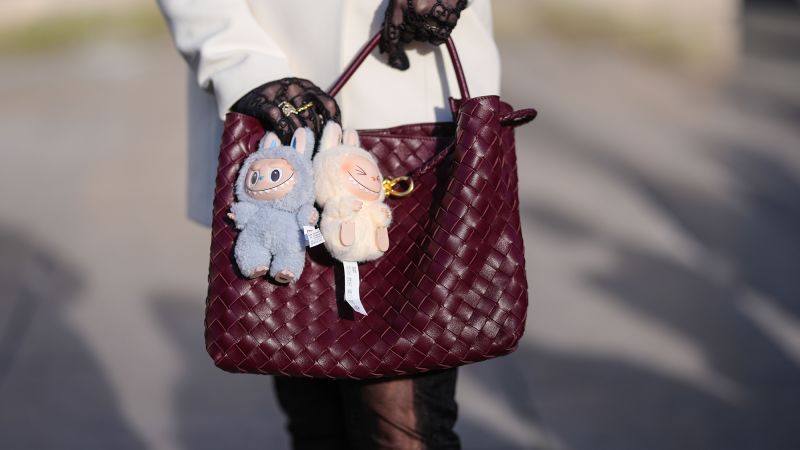In recent years, the world of fashion and luxury goods has seen a surprising influx of an unconventional accessory: the plush toy. This peculiar trend has been personified in the sociable and whimsical character known as Labubu, a small Nordic elf-like plush that marries cuteness with a hint of mischief. Particularly popular among Gen Z and millennials, Labubus have become a must-have for many, including Naomi Lin, a medical student from Nebraska, who has a collection of these quirky toys. Lin’s Labubu, stylishly adorned with a tweed outfit and a miniature Chanel purse, highlights the toy’s appeal as a high-end accessory, contrasting starkly with more traditional luxury brands like Manolo Blahnik or Prada.
Labubus possess a unique charm that captivates fans with their soft bodies and affinity for costumes, evoking the imagery of beloved childhood collectibles, yet their sharp teeth and glaring eyes lend them an uncanny edge. This juxtaposition of cuteness and eeriness contributes to their burgeoning popularity, creating a fashion phenomenon. As noted, these plush toys are often accompanied by their fellow creatures from the “The Monsters” storybooks, released in 2015, and usually handed out in blind boxes, which adds an element of mystery and excitement to the purchasing experience—consumers never quite know which one they will get.
The company behind these delightful creatures, Pop Mart, has witnessed phenomenal growth not only in China but across international markets, including the US, where the demand for Labubus continues to soar. In 2024, these whimsical toys contributed a staggering 3 billion yuan, approximately $410 million, to Pop Mart’s total revenue of 13.04 billion yuan, demonstrating their resilience even amidst trade tensions between the US and China. Pop Mart’s revenue growth outside of China has been especially astounding, rising by over 375% and capturing the desires of a broad consumer base.
Lines stretching for blocks outside Pop Mart’s brick-and-mortar locations in major cities such as Los Angeles, Paris, and Bangkok signify the growing trend, especially during the launch of new merchandise. The wide variety of Pop Mart’s figurines such as Baby Molly, Crybaby, and Dimoo serves to enhance its allure, ensuring fans always have something new and exciting to look forward to.
Moreover, the allure of these plush toys has generated significant demand, with prices sometimes reaching up to $85, and some sought-after variants being resold for hundreds of dollars on platforms like StockX. This phenomenon isn’t isolated; it reflects a broader cultural shift where younger generations actively engage with collectible toys in a manner akin to luxury goods.
Interestingly, it seems that Pop Mart’s success is intertwined with a cultural appreciation for cute aesthetics that resonates deeply within American society, despite instances of anti-Asian sentiment. According to Anne Cheng, an English professor at Princeton University, there exists a historical precedent in how Americans have embraced cute products from Asia. These plush toys serve not only as delightful objects of affection but also as gateways to luxury that are more accessible to the average consumer.
Cheng argues that while prejudices persist concerning Asian communities, products crafted from these cultures find acceptance easier when packaged in consumable formats. This duality—the delight and joy derived from these toys amidst societal biases—speaks volumes about the intersections of culture, commerce, and consumerism today.
Celebrity endorsements also play a role in propelling Labubus into the limelight; K-pop sensations and icons like Lisa and Rihanna sport these plushies, adding considerable street cred to their desirability. As consumers increasingly gravitate toward affordable luxuries—especially in uncertain economic times—they resonate more with items priced between $20 and $40, resembling ease of purchase compared to high-end designer goods.
And yet, owning a Labubu isn’t devoid of challenges. Most blind box toys revolve around the thrill of unboxing, akin to the gambling high—a customer never knows what they will unearth. This unpredictability has stirred regulatory concern in China, which has begun imposing restrictions to limit childhood exposure to potentially addictive buying behaviors.
Pop Mart continues to evolve amidst challenges such as the trade wars affecting pricing and availability. While the company’s management has assured consumers that they will absorb tariff repercussions, recent price increases hint at a balancing act between maintaining affordability and sustaining profit margins in the competitive toy market.
In conclusion, the charm and appeal of Labubus extend far beyond mere plush toys. They represent a complex blend of cultural fascination, economic opportunity, and psychological intrigue that resonates profoundly with contemporary consumers. The surge in their popularity encapsulates a pivotal moment in which luxury, affordability, and nostalgia converge, enabling a new wave of consumer culture that is both whimsical and astute. As more consumers seek joy and a sense of connection through these quirky collectibles, it seems unlikely that this trend will fade anytime soon, highlighting the timeless allure of cute and capricious companions in fashion.



